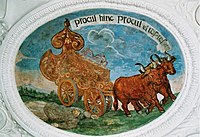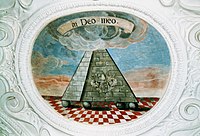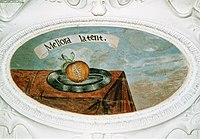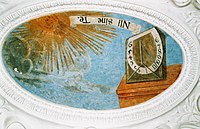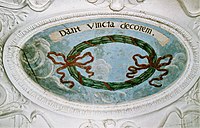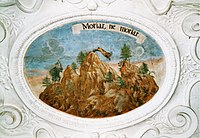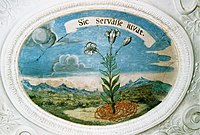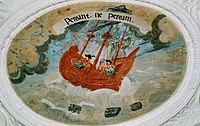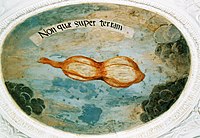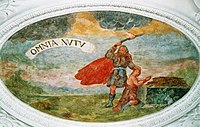Emblematic painting cycle
The emblematic painting cycle in the cloister of the former Augustinian canons of Wettenhausen , which belongs to the municipality of Kammeltal in the Bavarian district of Günzburg ( Swabia ), was created by an unknown artist towards the end of the 17th century. The cycle consists of 24 pictures in oval fields framed by stucco at the apex of the barrel-vaulted ceilings of the cloister wings and the connecting passage between church and cloister.
history
The cloister of the Wettenhausen monastery, which dates back to the 12th century - as evidenced by an uncovered Romanesque twin arcade - received its current decor around 1680. After the destruction of the Thirty Years' War , the renovations and expansions started at the beginning of the 17th century 1566 continued imperial direct abbey. Reich prelate Dionysius von Rehlingen , under whose direction the new construction of the monastery church was tackled, commissioned Wessobrunn plasterers to decorate it , who are also responsible for the redesign of the cloister wing. Christoph Gigl and Georg Vogel are named by name.
Image program
The pictures are made using the technique of secco painting, in which the colors are applied to the dry plaster. All representations are provided with Latin inscriptions, which are usually inserted in tapes at the upper edge of the picture. The symbols were commissioned by the Wettenhausen provost Dionysius von Rehlingen. Next to him, Augustinus Erath, who lived as a canon in Wettenhausen, played a major role in developing the image program. Augustinus Erath had translated the collection of emblems Il mondo simbolico by the Italian canon Filippo Picinelli , published in Milan in 1653, into Latin and expanded it to include further examples from the Wettenhausen cycle. This resulted in the Mundus symbolicus , the most important collection of symbols of the 17th century, the first edition of which was published in Cologne in 1681 and which was followed by a further eleven editions.
The emblems show important features of the monastic life of the Augustinian canons. The image motifs are not only taken from the Old and New Testament, but are also located in the areas of mythology and astronomy, seafaring and mechanics, flora and fauna. The inscriptions do not explain the pictures, but support the viewer in tracking down the spiritual meaning of the representations. Not only Bible verses serve this purpose, but also quotations from Cicero and Virgil, Bernhard von Clairvaux or Torquato Tasso, for example. It is also worth mentioning that there are no clear explanations of the symbols. Every viewer has to find his own access to every symbol and this can change with every new look at the symbol. The following explanations only give a rough direction, details can possibly be interpreted differently.
Two writings are important for understanding the cycle: the Augustinian rule and the Constitutiones canonicae, a commentary on this rule written by Dionysius von Rehlingen. The constitutions begin with references to choral prayer and mass service and give instructions for the prelate and the monastery community. Thoughts on virtues follow, lastly on the three evangelical counsels . It concludes with advice on the treatment of the sick, the dying and the dead.
Of the 24 emblems, three are located in the connecting passage between the church and the cloister, six each in the north and south wing of the cloister, four each in the west and east wing and the last one at the entrance from the cloister to the convent wing. This spatial distribution is also linked to a content structure. While principles of monastic life are discussed in the north wing, the symbols in the three other wings each indicate one of the three religious vows of poverty, chastity and obedience.
Unlike, for example, in the cloister of the Ottobeuren Abbey or in the corridors of the Wessobrunn monastery, the emblems in Wettenhausen are not arranged in the direction of view of the corridor, but at right angles to it, so that the individual image can be viewed in the direction of the cloister garden.
Link between the church and the cloister
The first two symbols address an important part of monastic life, the altar service.
- Probet autem se ipsum homo ( Let man test himself) (1 Cor 11:28)
The text is from the New Testament, but the picture refers to the Old Testament and shows a priest holding his hands in the water that flows out of the brazen sea to purify himself (2 Chr 4: 1-6) .
- Procul hinc procul este profani (Stay away, unholy, flee) (Aeneid VI, 258)
These words are taken from the Aeneid of Virgil. The Sybille von Cumae addressed it to Aeneas and thus forbade "unsanitary" to enter the underworld. The picture thematizes the boundary between the world of the living and the dead, shows the mysterium tremendum , the trembling at the presence of the sacred. In the picture the Ark of the Covenant is being pulled to Jerusalem on a cart by two cattle. Next to the chariot lies the dying Usa, who was slain by God because he dared to touch the ark (2 Sam 6: 6-7).
- In Deo meo (In my God) (Ps 18:30)
With my God I jump over walls , it says in Psalm 18:30. Deo meo is also the motto of Prelate Dionysius von Rehlingen. The picture shows a pyramid, the top of which has disappeared into the clouds. The front of the pyramid bears the prelate's coat of arms.
North cloister wing
- Humiliora minus (the lowlands are less hit)
Lightning strikes on a mountain top. Those who are high up are at greater risk of falling prey to pride. It is easier for those below to practice humility. The fact that the virtue of humility (humilitas) is pointed out right at the beginning in this wing fits well with the Constitutiones, in which Dionysius von Rehlingen writes that humility is the strong foundation for all other virtues.
- Iugum meum suave et onus leve (My yoke does not press me and my burden is light) (Mt 11:30)
A soaring eagle has a gold chain hanging around its neck. The picture is to be seen as an encouragement to the canons to understand the demands on their monastic life as easy and to see them as a gain.
- Meliora latent (the better is hidden)
A pomegranate lies on a plate . Many sweet seeds are hidden under its bitter skin. With this emblem the monks are encouraged to be humble and self-contained.
- Nil Sine Te (Nothing Without You)
The sun is shining on a sundial. You can only tell the time on the watch when the sun is shining. Man is also dependent on God. The inscription is upside down. So while you can look at the picture in the direction of the cloister garden, the inscription can be read from the garden. Nil Sine Te is - slightly modified - taken from a sermon by St. Bernard of Clairvaux.
- In captivitate liber (free in captivity)
A hand loosely holds a string to which a bird is tied. It is a symbol for monastic life, which does not mean imprisonment, but a freedom to be guided by God's hand.
- Dant vincta decorem (The ribbons are used for jewelry)
Just as the ribbons, which are wrapped around a laurel wreath and end in bows, serve as jewelry, so the vows distinguish the religious. The inscription in Picinelli and in other emblem books reads Dant vincla decorem (vincla as plural of vinclum, the ribbon). It is possible that the “l” became a “t” during a restoration. It is known that there have been several errors during restoration work.
West cloister wing
The symbols of this wing are dedicated to chastity (castitas).
- Moriar ne moriar (ready to die, not to die)
An ibex leaps to its death from a mountain top to avoid a hunter. The picture conveys a radical rejection of a decline in this world and shows the religious that it is better to suffer death than to break one's vow.
- Potius mori quam foedari ( I'd rather die than be dishonored)
An ermine stands on a boulder in the middle of swamp and morass. The idea behind the picture is based on the natural history of the time that this animal would rather die than get dirty.
- Sic servasse iuvat (it pleases to be preserved like this)
A white lily is surrounded by thorns at its foot, an allusion to St. Benedict throwing himself into thorn bushes to protect himself from temptation.
- Dat pretium candor (The gloss determines the value)
On a table lies a shell half with a pearl as a symbol of purity and chastity.
South wing of the cloister
Now follow the emblems that refer to the vow of poverty (paupertas).
- Sine pondere sursum (without weight upwards)
A raptor is about to fly up and has broken a chain with which it was tied to the globe. Likewise, the religious should detach himself from the world.
- Propry nil habet ista Domus (This house is not privately owned)
The beehive is a symbol of the demand on religious to renounce property. It is considered the theft of God to appropriate anything from common property. Picinelli refers to the Historia naturalis of Pliny the Elder , according to which there is only common property in the state of bees.
- Relicturo satis (He who leaves everything is enough)
The philosopher Diogenes is represented in his barrel. He is considered a role model for a needless life and should encourage the canons in their vows of poverty.
- Se obtulit Vni (she turned to the one)
A sunflower in a well-ordered baroque garden faces the sun. Likewise, man should turn away from everything and turn to God. It was believed that the European solstice had a special relationship with God because its white flowers always turn towards the sun. Later this property was mistakenly transferred to the sunflower, which was depicted in the emblem instead of the solstice.
- Pereant, ne peream (you may perish so I don't perish)
On a ship in distress, the seafarers throw the cargo overboard. Even man can only save himself if he breaks away from all earthly possessions. Picinelli quotes from a penitential sermon by St. Basil: As long as there is still time before the shipwreck is complete, the heavier loads should be put aside and, before the ship sinks, the goods for which one sought unreasonably should be thrown out .
- Non quae super terram (not what is on the earth) (Col 3,2)
The strange being is supposed to represent a bird of paradise and admonish man to direct his striving towards the heavenly. It was believed that the bird of paradise would always be high in the air, and since it had no feet, it would barely touch the earth and only feed on the morning dew. The text comes from Paul's letter to the Colossians, which says: Set your mind on the heavenly and not on the earthly!
Eastern cloister wing
In the last wing, the virtue of obedience (oboedientia) is discussed.
- Obedientia prae Victima (obedience is better than sacrifice) (1 Sam 15:22)
The picture shows King Saul and Samuel in front of a burnt offering altar. The subject of the depiction is an Old Testament story in which King Saul is punished for disobeying Yahweh . He was supposed to kill all enemies on a campaign, but Saul spared some of them. Though Saul then wanted to offer a burnt offering, he was rejected by Yahweh because he was disobedient.
- Ad utrumque paratus (ready for both) (Aeneis II, 61)
A bull stands between a plow and a sacrificial altar on which a fire burns. The obligation of obedience requires the willingness to do as well as to suffer, to be active in life, but also to die.
- Non transgreditur (she will not cross it)
The sun is in the zodiac between Libra and Pisces . Just as the sun does not cross the zodiac, the obedient human being should submit to what is God given and accept the limits set by God.
- OMNIA NVTV (Everything According to the Will of God) (Cicero, Cat. III, 21)
The scene shows the sacrifice of Isaac by Abraham , who showed his absolute obedience by willing to kill his own son at the behest of God. The text is taken from Cicero's third speech against Catiline, in which it says, " that all that we see, and especially this city, is guided by the rule and power of the immortal gods ."
Ascent from the cloister to the convent wing
The last symbol is between the chapter house and the refectory. While all other emblems have an elliptical shape, here we find a square with an arcuate bulge in the middle of each of the four sides. This is the second inscription that is upside down so that one can look at the picture from one direction and read the text from the opposite direction.
- Omnia tempus habent (everything has its hour) (Koh 3,1)
In the middle of the picture is a blooming rose bush. There are clouds on the left and a strong wind is blowing. There is a watering can on the floor. The sun is shining on the other side and there is a sickle on the ground. The emblem shows contrasts. It wants to convey to the viewer that a successful human life must be characterized by the experience of joy and suffering, prosperity and also asceticism. The placement of the picture in front of the refectory also indicates the interplay and the correct relationship between speech and silence.
literature
- Georg Dehio : Handbook of German Art Monuments - Bavaria III - Swabia (arr.: Bruno Bushart , Georg Paula) . 2nd Edition. Deutscher Kunstverlag , Munich 1989, ISBN 3-422-03008-5 , p. 472 .
- Andreas Beck: Monks, walls and emblems. Architectural emblems in the cloister of Wettenhausen Monastery (1680/90) . In: Nina Bartsch, Simone Schultz-Balluff (Ed.): PerspektivWechsel. Or: The Rediscovery of Philology , Vol. 2, Erich Schmidt Verlag, Berlin 2016, ISBN 978-3-503-16579-7 , pp. 289–375.
- Katharina Winbeck, Gertrud Rank: Wettenhausen Monastery. History and cultural significance . Kunstverlag Josef Fink, Lindenberg 2011, ISBN 978-3-89870-717-6 .
- Dietrich Donat: The cloister emblems of the Augustinian canons of Wettenhausen . In: Wettenhausen Monastery. Contributions from the past and present, looking back on its thousand-year existence 982-1982 . (Günzburger Hefte 19), Konrad Verlag, Weißenhorn 1983, ISBN 3-87437-205-7 , pp. 45-59.
- Cornelia Kemp: Applied Emblematics in South German Baroque Churches . (Art Studies, Volume 53), Deutscher Kunstverlag, Munich and Berlin 1981, ISBN 3-422-00725-3 , pp. 323-325
Web links
Individual evidence
- ^ Dietrich Donat: The cloister emblems of the Augustinian Canons of Wettenhausen , p. 48.
- ↑ Cornelia Kemp: Applied Emblematics in South German Baroque Churches , p. 323.
- ↑ Dietrich Donat: The cloister emblems of the Augustinian Canons of Wettenhausen , p. 49.
- ^ Dietrich Donat: The cloister emblems of the Augustinian Canons of Wettenhausen , p. 57.
- ^ Dietrich Donat: The cloister emblems of the Augustinian Canons of Wettenhausen , p. 52.
- ^ Dietrich Donat: The cloister emblems of the Augustinian Canons of Wettenhausen , p. 53.
- ^ Dietrich Donat: The cloister emblems of the Augustinian Canons of Wettenhausen , p. 53.
- ↑ Marcus Tullius Cicero: In Catilinam III
- ^ Dietrich Donat: The cloister emblems of the Augustinian Canons of Wettenhausen , p. 55.
Coordinates: 48 ° 23 '47.4 " N , 10 ° 21' 31.7" E



